Warlock: Master of the Arcane – Preview
by Chris
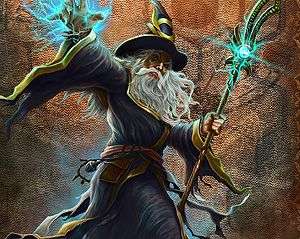 Being a conduit between you, the reader, and the games you’ve yet to play I feel obligated to point out two very important facts. The first is (and I say this with a level of apprehension) that aside from one other Nintendo DS game I’ve never played a turn based strategy before. Ever. My only venture into this world was through the Advanced Wars series – an excellent series, admittedly, but it’s pretty much a flavour of game unto itself; I’ve not seen anything like it. It certainly doesn’t do turn based on a global scale like the Total War, Civilisation, and Warlock: Master Of The Arcane variety of releases. This puts me at something of a disadvantage, having literally no clue what I’m doing. A positive however is that it provides a relativity untainted view of the genre, which is something rather rare.
Being a conduit between you, the reader, and the games you’ve yet to play I feel obligated to point out two very important facts. The first is (and I say this with a level of apprehension) that aside from one other Nintendo DS game I’ve never played a turn based strategy before. Ever. My only venture into this world was through the Advanced Wars series – an excellent series, admittedly, but it’s pretty much a flavour of game unto itself; I’ve not seen anything like it. It certainly doesn’t do turn based on a global scale like the Total War, Civilisation, and Warlock: Master Of The Arcane variety of releases. This puts me at something of a disadvantage, having literally no clue what I’m doing. A positive however is that it provides a relativity untainted view of the genre, which is something rather rare.
My second confession, albeit a minor one, is that when it comes to strategy games I’m not actually very good. While I like to think myself as the Napoleon Bonaparte of all types of warfare, I’m more akin to Napoleon Dynamite. I’ve got the tactical prowess of a raccoon in a skip and I’ve got a win to lose ratio that would make Poland blush.
With all that said Warlock: Master Of The Arcane, from publishers Paradox Interactive, is a turn based strategy set in the world of Ardania. You take on the role of a Great Mage, whose task it is to build a powerful empire to conquer the other Mages who vie for the title of ‘Warlock’. So far, so simple. After a neat little introduction video you’re required to pick your character. This person will add permanent buffs to your play such as magic, gold, and food. Hang on… food? Food’s a resource? Blimey, this is different. After the character selection there’s a choice of the size and type of map you want to play on, which can range from one huge continent to several small islands. I carefully opted for a small continent thinking this would be safest option and would allow me to get to grips with the game.
Upon starting, however, it became apparent extremely quickly just how out my depth I was. While players of the Civilisation and Total War games may feel right at home in this very dedicated fantasy setting, I was at a loss. That’s not to say I didn’t get stuck in. I had a small fortress, some men, farm lands – it was all very quaint. Were I not spurred on by ambitions of murder and world domination I could have quite happily sat back and relaxed.
 One common theme in Real Time Strategy games is the ‘fog of war.’ This is displayed in different ways in certain games. Command and Conquer titles usually display it as blacked out space, Dawn Of War had the visible landscape in a brown murky colour (you could see the area, just not what was going on). Warlock has clouds. This isn’t a joke, there are actually clouds covering the area. More impressive still is that you can see the tips of mountains and very tall monsters poking through the top of the cloud cover. This is both reassuring as a point of reference and also to know where tall places and monsters I don’t want to go anywhere near are located.
One common theme in Real Time Strategy games is the ‘fog of war.’ This is displayed in different ways in certain games. Command and Conquer titles usually display it as blacked out space, Dawn Of War had the visible landscape in a brown murky colour (you could see the area, just not what was going on). Warlock has clouds. This isn’t a joke, there are actually clouds covering the area. More impressive still is that you can see the tips of mountains and very tall monsters poking through the top of the cloud cover. This is both reassuring as a point of reference and also to know where tall places and monsters I don’t want to go anywhere near are located.
Considering the main objective is to conquer the land before me, I got acquainted with moving units around and generally seeing what mischief I could get up to. This proved to be the first in a long line of mistakes I would make in generally pissing off the wrong people. I had several pre-built units at my disposal, ranging from archers to general hand-to-hand men. I also seemed to have a group of token women-folk. This seemed odd because, after their untimely death at the hand of a group of giant bears not minutes into the game, I’ve yet to remember what they were and had not seen an option to build them. Considering that I thought they were the best and most effective unit to fight a group of giant bears it’s all for the better really.
With the women eaten, the bears wandered off and I was quite happy to let them do so. I took the time to use the somewhat misunderstood and less popular of the mouse buttons (the right one) and by clicking on units revealed an absolute compendium of information. A little mini back-story, health, damage potential, any buffs, experience points, resistance points. There was probably room for a mini-bar and dartboard in there somewhere. Developers underestimate the use of a little bit of back-story about individual units. For me, it makes the game seem more real and believable, so kudos to developers Ino-Co Plus for including that; it certainly compliments the fantasy setting.
I started pushing units out further in different directions and constructed some more buildings. I’m hoping that the finished version will have a little more depth in terms of what buildings unlock what else. Although there is text to tell me what each one unlocks, I don’t then know what that new building does. It’s not a huge problem, but I can only seem to construct one building at a time, and for a greenhorn it’s a little unclear if I’m heading down a suitable path, given my one objective of taking over the world. For all I know I could be pouring resources into baking the best pumpkin bread for the town’s annual pumpkin throwing tournament. Speaking of which, a word to the wise: pumpkins are not effective shields against fire. Placing a group of men in a pumpkin field is not acceptable cover in a combat situation. Like I said: Napoleon Dynamite.
As I explored the land before me, the full breadth of the world that Ino-Co Plus has created became clear. This is very much a living, breathing world that is interacting with itself without concerning you. Other battles are being waged, other cities are expanding. The other Great Mages are fighting wars below the clouds and beyond your borders. That didn’t really concern me early on because having killed a couple of groups of spiders and rats in the forest I thought I’d take on a bigger foe. This is where Warlock has impressed me the most so far: the variation of enemies. I’ve encountered no less then twelve different enemies in the opening two hours of play. Some had allegiances, others were wild creatures, but all of them wanted to see me dead. Having killed a couple of things, I came across a Greater Fire Element. It was essentially a giant walking mix of molten rock and lava – clearly something an iron sword and some arrows will kill, I thought. I’ve even got this handy fire spell I’d just researched to throw at it. Maybe I’ll overheat it and it will spontaneously combust. Bonaparte is spinning in his grave at the thought, I’m sure. I positioned my units carefully in range of him and went for it.
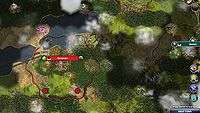 |
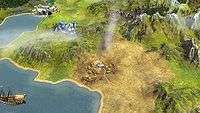 |
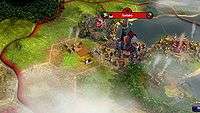 |
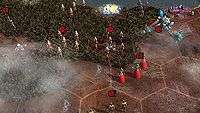 |
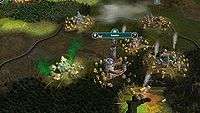 |
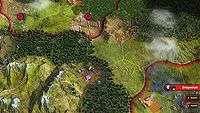 |
The following minute of his life went as follows. “It’s a lovely day here in the forest. What should I do? Go see that Greater Plasma Element over by that abandoned fort? What’s this? A couple of hundred men. Well, hello guys. Don’t fire those arrows they’ll aggravate my allergies. Please don’t…don’t… *cue giant sneeze…* Ugh, oh my goodness… I’m so sorry!”
From my perspective I fired about five arrows at this walking volcano and he proceeded to wipe out an entire squad with as little effort as a sneeze. Clearly he felt guilty because he ran off and tagged in what appeared to be a Greater Plasma Element who had no problems killing another squad of men. I beat a hasty retreat, smashing the defence button and casting heal spells as I went. Thankfully the big bitch didn’t follow me.
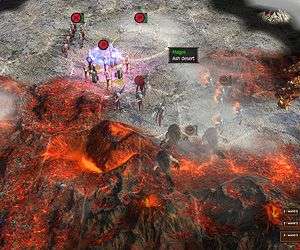 Spells play a large part in the gameplay, requiring more of a tactical element than first thought, and are broken down into five different areas. You first have to research the spell and when this is done it is added to your spell book and the next tier is ready for you to research. They cost Mana to cast which is gained in a variety of ways. The Great Mage I picked at the started had some stats which increased Mana regeneration – something which proved useful as the game advanced further. Much like the building menu, I hope the final build has some overall chart or advice about just what you’re unlocking by purchasing said spell. Spells or magic in video games can include plenty of choices and I’m sure Master Of The Arcane is no different. For that reason a chart showing me what sort of direction I’m going in would be helpful.
Spells play a large part in the gameplay, requiring more of a tactical element than first thought, and are broken down into five different areas. You first have to research the spell and when this is done it is added to your spell book and the next tier is ready for you to research. They cost Mana to cast which is gained in a variety of ways. The Great Mage I picked at the started had some stats which increased Mana regeneration – something which proved useful as the game advanced further. Much like the building menu, I hope the final build has some overall chart or advice about just what you’re unlocking by purchasing said spell. Spells or magic in video games can include plenty of choices and I’m sure Master Of The Arcane is no different. For that reason a chart showing me what sort of direction I’m going in would be helpful.
I decided that it would be more beneficial to actually focus on attacking a stronghold, rather than going on a genocidal campaign against wild animals and things that kick my ass. There had been just such a stronghold literally four spaces over near a water area that was constantly sending goblins to attack me. Attacking Stronghold Goblin Hill (very original) proved to be tons of fun. It was a mix of sending waves of arrows in, spells to assist with any escaping units and men to finish it off.
When you conquer a stronghold it becomes yours with a few crucial things to remember: first (and mostly impressively), even though they’re flying your flag, they don’t all then become human. Quite the opposite. From that particular stronghold I was now able to build Goblin units and all the diversity that bought. This really increases the desire to conquer other areas because it adds another layer to your army which may help combating a particularly difficult enemy. Secondly, even though you’ve captured the base, the stronghold needs to be repaired, meaning that any savvy opposition could nip in and finish off your depleted forces before you know what’s going on. Finally, and this is one for the newbies like myself, when you take on a new area, you take it on for better or for worse. Much like marrying a sexy twenty one year old porn star, there is plenty of fun to be had but once you’ve had your way with her, you’re going to be left with a wife who takes her clothes off for a living. In Master Of The Arcane, I’m left with a huge population who are starving, no farmable land, and an alien race sucking my money and food coffers dry. Great move Genghis Khan.
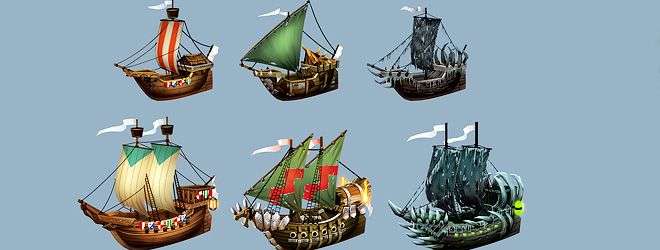
How many of these do you think you can fit in a duck pond?
Not that I wished to concern myself with the goings on of the peasant folk anyway. I’m a Great Mage after all. My concerns stretch purely to my army who, after battle, had levelled up a couple of times and could be upgraded in various ways. I had options to improve various attributes, from damage resistance and attacking power, to gaining extra experience and regenerating health. With the stronghold now mine I began to construct the new buildings that were available to me. One of these was a harbour and, not having had the luxury of water at my first stronghold, I constructed one with much intrigue. Minutes later I’d queued up around six ‘Carrav’, which were small little ships. This game just got a whole lot cooler. I’d be the scourge of the seas, the floating bringer of death, the biggest, baddest, pirate that ever sailed the seas of Ardania! The only problem with these grand ambitions was that I’d built my harbour in what can only be described as a duck pond. I also couldn’t find out how to cancel units. So, twenty minutes and a very precious six hundred gold later, I had the most heavily fortified, well armed, invasion-proof duck pond that I swear you will ever see in a video game.
My duck pond did slightly stretch into unexplored grounds though, and so with a scouting party/invasion fleet I explored further into the clouds. I came across an undead looking chap who quickly suggested we ally with each other. I was more then happy to do that because firstly he was a skeleton and probably knew a thing or two about war, and secondly his empire stretched across half the map. It appears that while you’re busy playing, the computer is more then happy to quench its own ambitious thirst and conquer an entire portion of the map. I quickly retreated to the other side of the duck pond in case the computer realised it was playing with a complete moron and decided he could crush with me little more than a wave of his hand.
 Everything up to this point had left me feeling happy with the time spent playing. I was, however, querying the absence of any ‘advisor’ or ‘diplomat’ types. I remembered that other titles of this kind had these people and it added another layer to the games. I’m not sure if I just overlooked them or if they’ll be in the finished build but, regardless, I personally didn’t feel it was less of a game without them. Enthusiasts of the genre may well feel different though.
Everything up to this point had left me feeling happy with the time spent playing. I was, however, querying the absence of any ‘advisor’ or ‘diplomat’ types. I remembered that other titles of this kind had these people and it added another layer to the games. I’m not sure if I just overlooked them or if they’ll be in the finished build but, regardless, I personally didn’t feel it was less of a game without them. Enthusiasts of the genre may well feel different though.
People questioning the amount of things to do in game, however, should pay attention as several times during the play I was given a variety of random quests. These basically revolved around killing different units – some of these were very easy, even for me. Others, such as the Paladins of Dauros, had me preoccupied for some time. They were hardcore and killed many of my men and the reward for finally sending them to the afterlife was some gold and a new spell. There appears to be a punishment for failing these quests, although I’m not sure if these are time based or how they work exactly; I didn’t see any timer and they killed plenty of my people (and even got inside my territory a few times). The idea of random quests appearing and giving you another avenue to deal with is certainly interesting, but there needs to be more to it than just killing or it will become more of a chore than anything else.
More importantly is what I stumbled upon – literally – at the end of play. Having conquered another stronghold I decided I was powerful enough to go and kill that Greater Fire Element who had cowardly floated off earlier. I did see him again but not before he completely vanished into thin air. Somewhat perplexed I saw he’d been standing on a Mystical Portal, so I sent a unit to do the same. Next thing I know they’ve been sent to a totally different part of the map, surrounded by Greater Elements of various flavours. Except they weren’t on a different part of the map. They’d actually been transported to a totally different plane of existence. I then noticed next to the mini-map that you could actually cycle through each plane. There were three in total. Fighting a war on three totally different fronts? Now that is very impressive. I’m not sure if three is the limit but I really hope it isn’t because that could be as brilliant as it could be insanely complicated.
By this point, I felt I’d spent enough time impersonating an inept Great Mage. Having little experience with this type of game I was impressed with what I’d come across in such a short space of time. The level of detail shown was excellent and I believe is quite important in this sort of genre. If you’re going to wage war for several hours at a time, you need it to hold your attention. With that said though, I found it was a game you could pick up and play for twenty minutes and then come back to if and when you wanted. Graphically it does look good, but I hope that the final build allows you to zoom in closer because I wanted to take a better look at my units and buildings and it would be a real shame if this was left out.
Overall, Warlock: Master Of The Arcane is shaping up to be a truly solid game. It does need a few tweaks to the final build, I believe, but from someone who has barely played anything of the genre, I’d happily continue playing this for weeks and months to come, especially considering I’d found two other planes of existence to attempt (and fail) to conquer. Certainly one to keep an eye on.
Last five articles by Chris














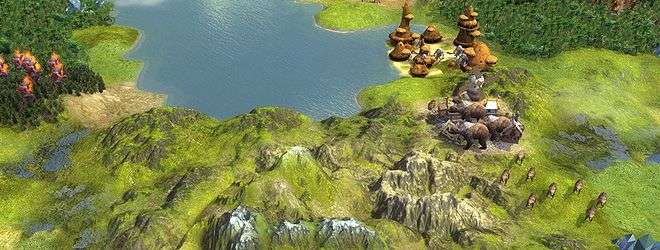







I really enjoyed this write up, mainly for your RTS ‘skillz’ than the allure of the game Classic stuff, not waiting to see if the water actually connects to any larger body, such as the sea before building a fleet – cracked me up
Classic stuff, not waiting to see if the water actually connects to any larger body, such as the sea before building a fleet – cracked me up  Also, if I’m honest, it sounds like the sort of thing I’d do…
Also, if I’m honest, it sounds like the sort of thing I’d do…
I really thought I was going to struggle to write anything. Then I decided to just literally write it as I experienced it rather than “This game is great cause….X Y Z”